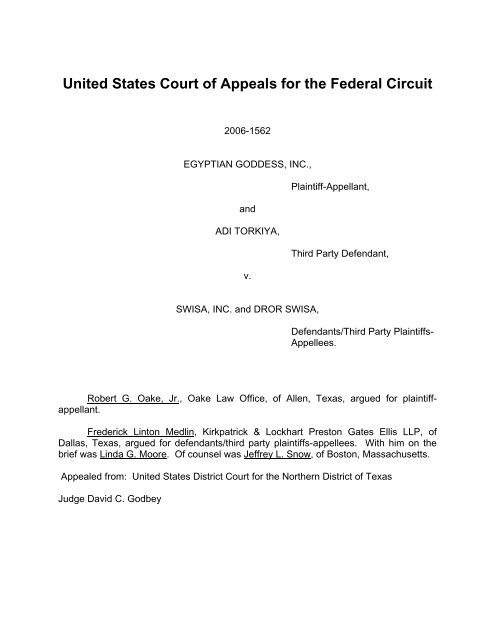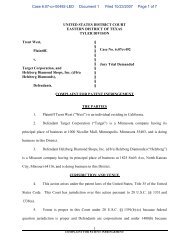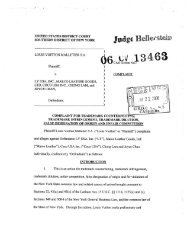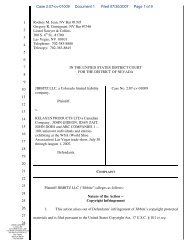Fed. Cir. 2007 - Patently-O
Fed. Cir. 2007 - Patently-O
Fed. Cir. 2007 - Patently-O
You also want an ePaper? Increase the reach of your titles
YUMPU automatically turns print PDFs into web optimized ePapers that Google loves.
United States Court of Appeals for the <strong>Fed</strong>eral <strong>Cir</strong>cuit<br />
2006-1562<br />
EGYPTIAN GODDESS, INC.,<br />
and<br />
ADI TORKIYA,<br />
v.<br />
SWISA, INC. and DROR SWISA,<br />
Plaintiff-Appellant,<br />
Third Party Defendant,<br />
Defendants/Third Party Plaintiffs-<br />
Appellees.<br />
Robert G. Oake, Jr., Oake Law Office, of Allen, Texas, argued for plaintiffappellant.<br />
Frederick Linton Medlin, Kirkpatrick & Lockhart Preston Gates Ellis LLP, of<br />
Dallas, Texas, argued for defendants/third party plaintiffs-appellees. With him on the<br />
brief was Linda G. Moore. Of counsel was Jeffrey L. Snow, of Boston, Massachusetts.<br />
Appealed from: United States District Court for the Northern District of Texas<br />
Judge David C. Godbey
United States Court of Appeals for the <strong>Fed</strong>eral <strong>Cir</strong>cuit<br />
2006-1562<br />
EGYPTIAN GODDESS, INC.,<br />
and<br />
ADI TORKIYA,<br />
v.<br />
SWISA, INC. and DROR SWISA,<br />
_______________________<br />
DECIDED: August 29, <strong>2007</strong><br />
_______________________<br />
Plaintiff-Appellant,<br />
Third Party Defendant,<br />
Defendants/Third Party Plaintiffs-<br />
Appellees.<br />
Before DYK, <strong>Cir</strong>cuit Judge, ARCHER, Senior <strong>Cir</strong>cuit Judge, and MOORE, <strong>Cir</strong>cuit<br />
Judge.<br />
Opinion for the court filed by <strong>Cir</strong>cuit Judge MOORE. Dissenting opinion filed by <strong>Cir</strong>cuit<br />
Judge DYK.<br />
MOORE, <strong>Cir</strong>cuit Judge.<br />
Appellant Egyptian Goddess, Inc. (EGI) appeals from the final judgment of the<br />
United States District Court for the Northern District of Texas, granting summary<br />
judgment of noninfringement of U.S. Design Patent No. 467,389 (the D’389 patent) in
favor of appellees Swisa, Inc. and Dror Swisa (Swisa). Egyptian Goddess, Inc. v.<br />
Swisa, Inc., No. 3:03-CV-0594-N (N.D. Tex. Dec. 14, 2005) (Summary Judgment<br />
Order). Because the district court properly determined that there is no genuine issue of<br />
material fact as to whether the alleged infringing product appropriates the point of<br />
novelty of the claimed design, we affirm.<br />
BACKGROUND<br />
The D’389 patent covers “an ornamental nail buffer” design as illustrated in the<br />
patent’s seven figures, one of which is reproduced below.<br />
On March 21, 2003, EGI sued Swisa, claiming that the D’389 patent was infringed by<br />
certain Swisa nail buffers. Swisa filed a counterclaim seeking declaratory judgment on<br />
various theories, including noninfringement of the D’389 patent. On March 3, 2005, the<br />
district court issued a claim construction order, construing the D’389 patent as claiming:<br />
A hollow tubular frame of generally square cross section, where the<br />
square has sides of length S, the frame has a length of approximately 3S,<br />
and the frame has a thickness of approximately T = 0.1S; the corners of<br />
the cross section are rounded, with the outer corner of the cross section<br />
rounded on a 90 degree radius of approximately 1.25T, and the inner<br />
corner of the cross section rounded on a 90 degree radius of<br />
approximately 0.25T; and with rectangular abrasive pads of thickness T<br />
affixed to three of the sides of the frame, covering the flat portion of the<br />
sides while leaving the curved radius uncovered, with the fourth side of the<br />
frame bare.<br />
Neither party challenges the district court’s claim construction.<br />
2006-1562 2
Swisa moved for summary judgment of invalidity and noninfringement—on the<br />
grounds that the accused designs did not infringe the D’389 patent under either the<br />
point of novelty or the ordinary observer test. The district court granted summary<br />
judgment on the ground that the Swisa nail buffers did not contain the point of novelty of<br />
the patented design. Summary Judgment Order, at 3-4. Specifically, the court stated<br />
that “[t]he only point of novelty in the D’389 Patent over the Nailco Patent is the addition<br />
of the fourth side without a pad,” which the Swisa nail buffers did not have. Id. The<br />
district court entered a final judgment, dismissing EGI’s claims of infringement with<br />
prejudice and dismissing Swisa’s counterclaims without prejudice. This appeal<br />
followed.<br />
We have jurisdiction pursuant to 28 U.S.C. § 1295(a)(1). We review the district<br />
court’s grant of summary judgment de novo. Winner Int’l Corp. v. Wolo Mfg. Corp., 905<br />
F.2d 375, 376 (<strong>Fed</strong>. <strong>Cir</strong>. 1990). Summary judgment is appropriate when there are no<br />
genuine issues of material fact and the moving party is entitled to judgment as a matter<br />
of law. Id.<br />
DISCUSSION<br />
I<br />
There are two distinct requirements for establishing design patent infringement.<br />
Bernhardt, L.L.C. v. Collezione Europa USA, Inc., 386 F.3d 1371, 1383 (<strong>Fed</strong>. <strong>Cir</strong>. 2004).<br />
The first, called the ordinary observer test, requires that “in the eye of an ordinary<br />
observer, giving such attention as a purchaser usually gives, [the] two designs are<br />
substantially the same . . . the resemblance is such as to deceive such an observer,<br />
inducing him to purchase one supposing it to be the other.” Gorham Co. v. White, 81<br />
2006-1562 3
U.S. (14 Wall.) 511, 528 (1871). The second, called the point of novelty test, requires<br />
that “no matter how similar two items look, ‘the accused device must appropriate the<br />
novelty in the patented device which distinguishes it from the prior art.’” Litton Sys., Inc.<br />
v. Whirlpool Corp., 728 F.2d 1423, 1444 (<strong>Fed</strong>. <strong>Cir</strong>. 1984) (citing Sears, Roebuck & Co.<br />
v. Talge, 140 F.2d 395, 396 (8th <strong>Cir</strong>. 1944)). “Both the ordinary observer and point of<br />
novelty tests are factual inquiries that are undertaken by the fact finder during the<br />
infringement stage of proceedings, after the claim has been construed by the court.”<br />
Bernhardt, 386 F.3d at 1383.<br />
Because the point of novelty determination is part of the infringement analysis,<br />
the initial burden is on the patentee to “present, in some form, its contentions as to<br />
points of novelty.” Id. at 1383. The point of novelty can be either a single novel design<br />
element or a combination of elements that are individually known in the prior art. See<br />
Lawman Armor Corp. v. Winner Int’l, LLC, 449 F.3d 1190, 1192 (<strong>Fed</strong>. <strong>Cir</strong>. 2006)<br />
(supplemental opinion on petition for rehearing); Litton, 728 F.2d at 1443-44. The<br />
patentee is not free to set forth any combination of elements as the point of novelty,<br />
rather, the point of novelty must include features of the claimed design that distinguish it<br />
from the prior art. 1 Litton, 728 F.2d at 1444; Goodyear Tire & Rubber Co. v. Hercules<br />
Tire & Rubber Co., 162 F.3d 1113, 1118 (<strong>Fed</strong>. <strong>Cir</strong>. 1998).<br />
1 Swisa asks this court to forbid the “shopping list approach” to selecting a<br />
point of novelty, whereby a patentee strategically selects a point of novelty that consists<br />
only of those elements of the claimed design that are also present in the accused<br />
design. See Hosley Int’l Trading Corp. v. K Mart Corp., 237 F. Supp. 2d 907, 911-13<br />
(N.D. Ill. 2002); Bush Indus., Inc. v. O’Sullivan Indus., Inc., 772 F. Supp. 1442, 1452 (D.<br />
Del. 1991). We agree with Swisa that the point of novelty should be determined by<br />
comparing the claimed design to the prior art and not to the accused design. As an<br />
appellate court, however, we review the merits of the asserted point of novelty and not<br />
the motive behind its selection.<br />
2006-1562 4
For a combination of individually known design elements to constitute a point of<br />
novelty, the combination must be a non-trivial advance over the prior art. 2 See Smith v.<br />
Whitman Saddle Co., 148 U.S. 674, 682 (1893) (analyzing whether the accused device<br />
contained the aspects of the claimed design that “rendered it patentable as a complete<br />
and integral whole”); Bernhardt, 386 F.3d at 1384 (noting that the point of novelty<br />
determination “is not especially different from the factual determinations that the district<br />
courts routinely undertake” in performing the obviousness inquiry); cf. Litton, 728 F.2d at<br />
1444 (applying the results of the obviousness analysis when determining the point of<br />
novelty of the claimed design); Goodyear, 162 F.3d at 1119, 1121 (noting that the court<br />
“adopted the same points of novelty that it had relied on in determining that the ’080<br />
patent was not invalid for obviousness,” and holding that “the district court did not<br />
clearly err in giving weight to those aspects of the ’080 tread that were necessary<br />
design aspects in sustaining the validity of the patent”). 3<br />
2 Contrary to assertions in the dissenting opinion, neither our precedent that<br />
utilized the results of an obviousness inquiry in determining the point of novelty nor our<br />
holding today is inconsistent with our Lawman decision. Lawman does not reject a nontrivial<br />
test for the point of novelty inquiry, but rather rejects the notion that the<br />
suggestion or motivation to combine prior art references must be proven as part of the<br />
infringement analysis. Lawman Armor Corp. v. Winner Int’l, LLC, 437 F.3d 1383, 1385<br />
(<strong>Fed</strong>. <strong>Cir</strong>. 2006). Rejecting application of the motivation to combine test is not<br />
tantamount to rejecting application of an obviousness type analysis. See KSR Int’l Co.<br />
v. Teleflex Inc., 127 S.Ct. 1727, 1741-42 (<strong>2007</strong>).<br />
3 The dissent suggests that determining the point of novelty by a nontriviality<br />
test conflates infringement and validity analyses. Dissenting Op., at 2. Design<br />
patent law has already intertwined the infringement and validity tests. The infringement<br />
test at issue in this case is called the “point of novelty” test. The question is not whether<br />
the infringement and validity analyses are similar or conflated, they already are. The<br />
question is: When the patentee claims a combination of old prior art elements as its<br />
asserted point of novelty should the test be one of anticipation or obviousness? We<br />
conclude that non-triviality ought to apply—if the standard is akin to anticipation then a<br />
combination with even the most trivial difference would meet the standard.<br />
2006-1562 5
II<br />
The district court properly determined that no reasonable jury could conclude that<br />
the point of novelty proffered by EGI is a non-trivial advance over the prior art. The<br />
parties do not dispute that the various design elements of the claimed design were each<br />
individually disclosed in the prior art. EGI’s asserted point of novelty is a combination of<br />
four of the claimed design’s elements: (1) an open and hollow body, (2) square cross-<br />
section, (3) raised rectangular pads, and (4) exposed corners. The district court<br />
properly found that one prior art nail buffer design, illustrated in U.S. Design Patent No.<br />
416,648 (the Nailco patent), shown below, contains each of these elements except that<br />
the body is triangular—rather than square—in cross-section. Summary Judgment<br />
Order, at 4.<br />
There is no dispute, however, that nail buffers having square cross-sections were<br />
widely known in the prior art. EGI admits that three prior art references cited during<br />
prosecution of the D’389 patent illustrate at least five nail buffer designs with a square<br />
cross-section. Moreover, the parties both agree that other well-known prior art designs,<br />
namely the Tammy Taylor buffers, also had square cross-sections. In light of the prior<br />
art, no reasonable juror could conclude that EGI’s asserted point of novelty constituted<br />
a non-trivial advance over the prior art. Thus, the district court did not err in rejecting<br />
EGI’s asserted point of novelty as a matter of law.<br />
2006-1562 6
The district court correctly determined that only if the point of novelty<br />
included a fourth side without a raised pad could it even arguably be a non-trivial<br />
advance over the prior art. The Swisa buffers have raised, abrasive pads on all four<br />
sides. When considering the prior art in the nail buffer field, this difference between the<br />
accused design and the patented design cannot be considered minor. See Litton, 728<br />
F.2d at 1444 (explaining that the differences between the claimed and accused designs<br />
must be considered in light of the differences between the prior art and the claimed<br />
design). Since the parties agree that the Swisa buffers do not contain a fourth side<br />
without a raised pad, summary judgment of noninfringement was properly granted. For<br />
this reason, the decision below is<br />
Each party shall bear its own costs.<br />
AFFIRMED.<br />
COSTS<br />
2006-1562 7
United States Court of Appeals for the <strong>Fed</strong>eral <strong>Cir</strong>cuit<br />
DYK, <strong>Cir</strong>cuit Judge, dissenting.<br />
2006-1562<br />
EGYPTIAN GODDESS, INC.,<br />
and<br />
ADI TORKIYA,<br />
v.<br />
SWISA, INC. and DROR SWISA,<br />
Plaintiff-Appellant,<br />
Third Party Defendant,<br />
Defendants/Third Party Plaintiffs-<br />
Appellees.<br />
This case concerns the scope of the point of novelty requirement in design<br />
patents. The majority decides this case on a ground that was not addressed in briefs or<br />
at oral argument by either party. In my view, the majority opinion departs from our<br />
precedent in fashioning a new rule—that a combination of elements cannot constitute a<br />
point of novelty in design patent cases unless the combination constitutes a “non-trivial<br />
advance” over the prior art. The majority equates its newly-fashioned non-trivial<br />
advance test with the requirement that a design patent be nonobvious over the prior<br />
art. 1 It then appears to limit the application of that test to cases in which the point of<br />
novelty involves a combination of prior art elements.<br />
1 The majority’s approach is in fact more restrictive than a nonobviousness test<br />
since it takes no account of secondary considerations.
It seems to me that there are multiple flaws in the majority’s approach. First, by<br />
conflating the criteria for infringement and obviousness, the test eviscerates the<br />
statutory presumption of validity by requiring the patentee to affirmatively prove<br />
nonobviousness. See 35 U.S.C. § 282 (“The burden of establishing invalidity of a<br />
patent or any claim thereof shall rest on the party asserting such invalidity.”). The<br />
burden of proof on obviousness rests with the accused infringer and must be<br />
established by clear and convincing evidence. Under the majority’s test, however, the<br />
patentee would have to prove nonobviousness in order to establish infringement.<br />
Second, the majority’s approach is at the same time too narrow and too broad. It<br />
is too narrow because it applies a special test only to designs which involve a<br />
combination of design elements. It is clear to me that a single point of novelty test must<br />
apply to all points of novelty, not just those involving combinations. That has invariably<br />
been the approach of our past cases. The majority’s approach is also too broad<br />
because it extends an obviousness-like test to each point of novelty, not merely the<br />
overall design (which is presently the sole focus of the obviousness analysis).<br />
Third, determining whether each combination point of novelty represents a “non-<br />
trivial advance” over the prior art requires a difficult and restrictive inquiry in design<br />
patent cases. As we have previously noted, “[d]esign patents have almost no scope.”<br />
In re Mann, 861 F.2d 1581, 1582 (<strong>Fed</strong>. <strong>Cir</strong>. 1988). Points of novelty in design patents<br />
are often not dramatically different from the prior art. It is difficult enough to assess<br />
whether an overall design would have been obvious; it is almost impossible to<br />
determine whether a particular design feature represents a trivial or substantial advance<br />
over the prior art. The majority appears willing to have this issue resolved on summary<br />
2006-1562 2
judgment without factfinding by a jury, thus relegating to the court the determination<br />
whether there is a non-trivial advance over the prior art, a determination which a court is<br />
ill suited to make and which it did not in fact make in this case.<br />
Fourth, the majority’s test is devoid of support in the case law. The most that any<br />
of the cases cited by the majority can establish is that we have, in certain instances,<br />
used the results of our obviousness analysis to determine the point of novelty under the<br />
point of novelty test. But no case has come close to requiring a showing of<br />
nonobviousness as part of the point of novelty test. 2 In Bernhardt, L.L.C. v. Collezione<br />
Europa USA, Inc., 386 F.3d 1371 (<strong>Fed</strong>. <strong>Cir</strong>. 2004), we considered only the question<br />
whether expert testimony was required for a party to establish infringement under the<br />
point of novelty test. In holding that such testimony was not required, the court merely<br />
observed that “[a] determination of the differences between the patented design and the<br />
prior art is not especially different from the factual determinations that district courts<br />
routinely undertake on other issues, such as obviousness.” Id. (emphasis added). This<br />
statement in no way suggests—as the majority appears to believe, see Maj. Op. at 5—<br />
that the substantive inquiries on obviousness and infringement should be merged. Our<br />
decisions in Litton and Goodyear do not support the majority’s test either. Litton Sys.,<br />
Inc. v. Whirlpool Corp., 728 F.2d 1423 (<strong>Fed</strong>. <strong>Cir</strong>. 1984), was a case in which, having<br />
determined that the differences between the patented design and the prior art rendered<br />
the overall design nonobvious, see Graham v. John Deere Co., 383 U.S. 1, 17 (1966),<br />
we then considered those differences to be the points of novelty. Litton, 728 F.2d at<br />
1442, 1444. In Goodyear Tire & Rubber Co. v. Hercules Tire & Rubber Co., 162 F.3d<br />
2<br />
Smith v. Whitman Saddle Co., 148 U.S. 674 (1893), long predated the statutory<br />
obviousness requirement.<br />
2006-1562 3
1113 (<strong>Fed</strong>. <strong>Cir</strong>. 1998), we held that the use of a similar approach by the district court<br />
was not clearly erroneous. Id. at 1119, 1121. It is one thing to suggest that a feature<br />
that renders a design nonobvious is also a point of novelty. It is quite another to hold<br />
that a point of novelty cannot exist unless it would also render the design nonobvious.<br />
Again, neither case establishes that there must be a showing of a non-trivial advance to<br />
find an asserted combination point of novelty.<br />
Finally, the majority’s test is in fact contrary to several of our cases. In Lawman<br />
Armor Corp. v. Winner International, LLC, 437 F.3d 1383 (<strong>Fed</strong>. <strong>Cir</strong>. 2006), we rejected<br />
applying an obviousness analysis to the determination of infringement. Id. at 1385. We<br />
stated explicitly that “[w]hether there is any suggestion to combine prior art references<br />
may be relevant in a validity inquiry to determine obviousness . . . but has no place in<br />
the infringement issue in this case.” Id. Other cases have treated the questions of<br />
novelty and obviousness in design cases as separate inquiries. Thus in In re Leslie,<br />
547 F.2d 116 (CCPA 1977), our predecessor court distinguished situations “where the<br />
novelty of the design is at issue” from situations “where, as here, the issue is one of<br />
obviousness.” Id. at 120; see also In re Blum, 374 F.2d 904, 908 (CCPA 1967)<br />
(although design had “an appearance which is novel in the strictest sense of the word,<br />
the rejection here is not for want of novelty but for obviousness”).<br />
I would address this case without reliance on the majority’s incorrect “non-trivial<br />
advance” standard. I respectfully dissent.<br />
2006-1562 4
















